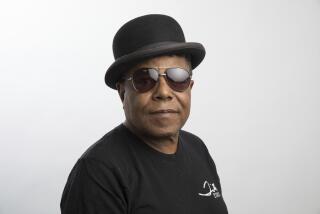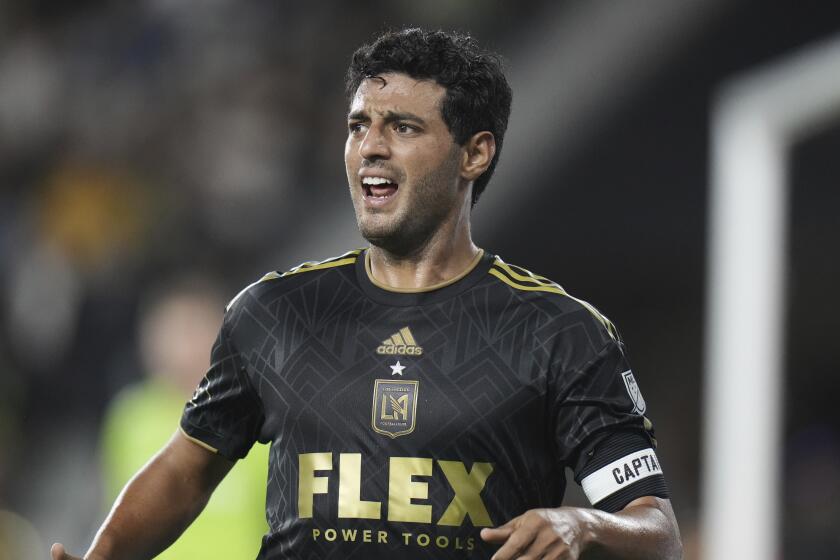Somber Reminder for Seahawks
- Share via
IRVING, Texas — Delirious Cowboy fans were screaming for Emmitt Smith. Frightened Seattle players were screaming for a doctor.
On the Texas Stadium field, Dallas cheerleaders shook pompoms for their hero. In the visitors’ locker room, Darrell Jackson convulsed so violently it sent his Seahawk teammates into a panic.
The contrast was gut-wrenching. While Smith was being feted for his accomplishment Sunday -- breaking Walter Payton’s all-time NFL rushing record -- Jackson, a third-year receiver, was suffering the aftermath of a devastating hit to the head by Cowboy safety Darren Woodson.
The extent of Jackson’s injury was not known when he was finally removed from the locker room on a stretcher and taken by ambulance to Baylor Medical Center.
Rich Gonzalez, a spokesman for the hospital, said Sunday night that Jackson was in stable condition and is expected to return to Seattle today.
Jackson never lost consciousness in the locker room, but his convulsions and odd behavior concerned even seasoned players who have seen all types of football injuries. Because they were on the field for Smith’s ceremony, Cowboy players and officials had no idea anything was amiss until after Jackson was taken to the hospital.
The hit was brutal. Woodson, who earlier in the game had moved into first place on the Cowboys’ career tackles list, drilled Jackson from the side as the receiver was leaping to catch a pass late in the game. It appeared to be a helmet-to-helmet blow, although slow-motion replays seemed to show Woodson was aiming for Jackson’s right shoulder. Either way, Jackson didn’t catch the ball and lay in a crumpled heap for several moments. Finally, with trainers surrounding him, the receiver climbed to his feet and walked slowly to the sideline.
Woodson was penalized for unnecessary roughness and might be fined by the league. Last week, Denver’s Kenoy Kennedy served a one-game suspension after his third such infraction of the season.
Several onlookers said Jackson looked normal enough for the rest of the game. He didn’t play after the collision though he spoke with teammates and seemed lucid.
But something was very wrong. Seahawk Coach Mike Holmgren was just finishing his news conference with about a dozen reporters when he was interrupted by a ruckus across the hall. Players began yelling for a doctor, a paramedic, anyone. Holmgren’s face dropped, and he pushed his way across the hall and into the locker room.
Just inside the door is a trainer’s room, where injured players are checked out or receive treatment before boarding the bus for the airport. Jackson was sitting, either on a chair or a table, and began to have a seizure. Although he never stopped breathing, he didn’t respond to the questions asked by Dr. Ed Khalfayan, the team physician.
“He was not receptive to any information,” Khalfayan said.
When the seizure ended, Jackson wasn’t himself. Normally upbeat yet even-keeled, now he was angry and needed to be physically restrained.
“He wasn’t throwing punches, he was just combative with the doctors,” said linebacker Chad Brown, who witnessed the scene. “But that’s just a reaction to a concussion.”
Holmgren said the reaction was similar to that of Gil Haskell, then Green Bay’s receiver coach, when he was bowled over on the sideline during a playoff game in 1995 and the back of his head smacked a sheet of plywood on the turf. That was at Texas Stadium too. Haskell, now Seattle’s offensive coordinator, fought the idea of going to the hospital at the time.
This time, Holmgren said Jackson recognized him and a few others.
“[But] we had a heck of a time getting him to lay still so we could load him into the ambulance,” Holmgren said. “Once we did that, he was on his way.”
Actually, the whole process took more than half an hour, and the scene outside the locker room was surreal. With sounds of the on-field celebration echoing through the stadium tunnels, the Seahawks -- showered and wearing expensive suits -- somberly walked up a ramp to their bus. They had just finished a 17-14 victory on a last-second field goal, but no one felt like talking.
An ambulance, with overhead lights flashing, was backed up to double doors leading into the locker room. Members of stadium security and the team’s media-relations department formed a human wall to block the sightlines of reporters and held up sheets and large pieces of cardboard to thwart photographers.
Two of Jackson’s fellow receivers, Bobby Engram and Koren Robinson, climbed into a sedan that would follow the ambulance to the hospital. Just before paramedics wheeled Jackson out on a stretcher -- his neck in a brace and his hands bound to the gurney -- Engram got out of the car and cupped his hand over the lens of a TV cameraman standing on a stepladder.
“You don’t need to take a picture of this,” Engram said.
It was somewhat reminiscent of Minnesota offensive lineman Matt Birk shooing away a photographer who was taking a picture of Korey Stringer writhing on the ground at Viking training camp in 2001. It was the last picture taken of Stringer, who died of heatstroke complications about 13 hours later.
No one could have known the full extent of Jackson’s injury, whether it was life-threatening or not. Holmgren looked shocked, almost ashen, when discussing the situation with reporters. The coach had one request: “Say a little prayer for him, please.”
The Seahawk players were doing that already, and no doubt kept him in their thoughts as they flew home to Seattle and he remained in a Texas hospital.
“This is football,” Brown said. “This isn’t worth dying for.”
More to Read
Go beyond the scoreboard
Get the latest on L.A.'s teams in the daily Sports Report newsletter.
You may occasionally receive promotional content from the Los Angeles Times.











